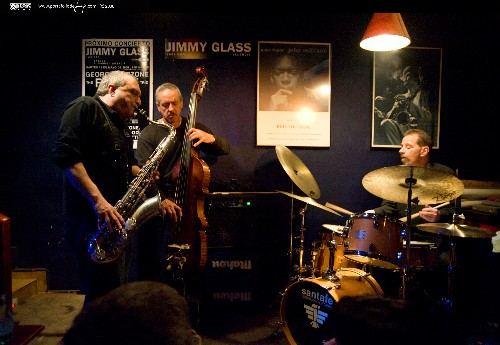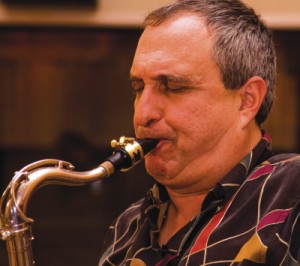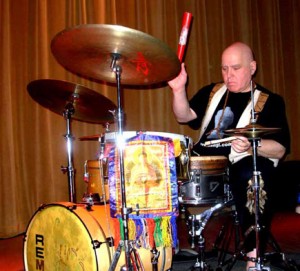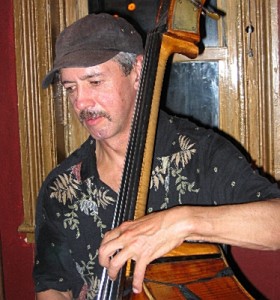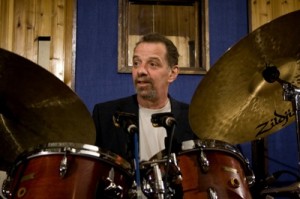Music Review — The Fringe, Dave Liebman, & Rakalam Bob Moses: All In, In Deep
In less than an hour, there had been enough substance to send the first set crowd into the Cambridge night shaking their heads in amazement, spirits lifted, all else forgotten for a brief still time. Another houseful of listeners waited on the sidewalk for the second set.
By Steve Elman
The best way to hear spontaneous improvisation is in live performance. I can testify to this from decades of hearing free jazz or the New Thing or open music or whatever you want to call it, in person and recorded.
You want to see the musicians look at one another. You want to note their head movements and their way of standing. You want to be able to hear the sounds in three dimensions. You don’t want to miss anything.
Maybe you’ve never had this experience. But if you want to know what the fuss is about, if you want to immerse yourself in top-class, spontaneous improvisation, if you want to hear Classic New Thing refined and perfected, then put this fact in your brain: The Fringe plays almost every Monday night at the Lily Pad in Inman Square. They start at 10:22 p.m. (That’s what it says on the Lily Pad’s website, and I’ve seen it happen, so I’m just reporting the facts).
You will not find food, beverages alcoholic or otherwise, a fancy sound system, or mood lighting at the Lily Pad. This is an art gallery by day and the House of Serious Music at night—no frills and no jive. No matter. You don’t need any other sensory stimulation to feel complete when the show’s over.
I was there on November 1. The gallery’s few chairs were occupied early and guarded jealously, because it wasn’t just a Monday with The Fringe. It was a quintet: The Fringe plus saxophonist Dave Liebman and drummer Rakalam Bob Moses. This was music that made people stand up and shout for joy.
For those not familiar with the players
I’ve written previously for The Arts Fuse about saxophonist Dave Liebman, who is a contemporary jazz master
The Fringe’s drummer is Bob Gullotti, a percussionist with powerful technique and incredible energy who holds a professor’s position at Berklee. He is the heartbeat of the trio.
George Garzone is one of the most intense and glorious saxophonists alive. He has a very successful career as leader of his own groups, guest artist with dozens of other bands, leader on six of his own CDs (the most recent is Among Friends on Stunt Records, with pianist Steve Kuhn), author of an instructional DVD set displaying his “Triadic Chromatic Approach,” and teacher at Berklee. Even so, he has been faithful to The Fringe as his home base and battery recharging station.
John Lockwood, ever sure of tone and tempo, is one of the area’s most respected bassists. He’s The Fringe’s newest member—he’s only been working with Bob and George since 1984, when he replaced founding bassist Richard Appleman, who’d been with the band for the previous 13 years. Lockwood is on the Berklee faculty as well.
(Maybe you haven’t bothered to do the math, so here’s something to astound: The Fringe has been a working band since 1972, when Gullotti, Garzone, and Appleman were all students. Thirty-eight years. They have 10 commercial releases as a group; the most recent is Live at the Zeitgeist, with guest Joe Lovano on Resolution.)
I was lucky enough to have them pull my coat in the early ’70s when I was a jazz DJ on WBUR. (“Hey, man, let us come up and jam.” “Why not?”) They soon became regulars on the air, particularly championed by my colleague Rob Battles, who hosted a live jazz show on Saturday afternoons. Pretty soon they were doing regular Mondays around town and occasional featured gigs on other days of the week. The hours I spent watching them build their rapport and work out the elements of their style are some of the most memorable of my life.
Bob Moses is associated for me with another few magic hours—a live WBUR broadcast from the Club Zircon (a Cambridge venue now long gone), when he performed as part of another cooperative trio. That group, called Open Sky, came to life whenever Moze and Dave Liebman could find a sympathetic bassist (among the group’s alumni are Frank Tusa and Steve Swallow). So, in some ways, the Lily Pad gig was Open Sky meets The Fringe.
Moses is a drummer of incomparable sensitivity and range, melding his voice, unorthodox stick technique, and a unique collection of instruments into a single flow of percussion. For those who care, this is what I saw him play on November 1: a small trap (no snare); a big drum (like a jumbo doumbek or djembe) with the bell pointed out, played with a foot pedal; a small bass drum played with a second foot pedal; a skin drum (a Native American tomtom?) with snares attached to its base somehow; a medium tom to the side; five ride cymbals, one of which approximated a gong sound; a baby hi-hat; a second hi-hat with asymmetrical cymbals; a small gong; and a medium gong.
This kit requires a lot of moving around and foot shifting, but one is so captivated by the music Moses makes that it is almost impossible to concentrate on the physical motions he uses to make it.
Moses and Gullotti made for an outstanding combination, contrasting an expansive and round approach to the drums with an explosive and hard-edged one—Moses is Eddie Blackwell to Gullotti’s Billy Higgins or Max Roach to the other man’s Philly Joe Jones.
Liebman and Garzone are complementary voices from the same generation of post-Coltrane saxophone language, but their styles are distinctive. If Liebman was a shaman at the Lily Pad, calling on the spirits and shouting incantations, then Garzone was a storyteller, with long arpeggiated lines relieved by huge, soulful bottom notes.
At the center, Lockwood had the task of listening, guiding, pulsing, nudging the harmony this way or that way. He was rarely in the spotlight but was vital to the way the music was made.
You might ask how exactly the music was made that night. Without any tunes or charts, without any visible prearrangement or cues, how did these five players decide on the notes to play and the form of the music itself? The easy answer is they just know.
But that’s a copout. I’ll try to tell you in the words below about how it happens, but remember that this can only be a black-and-white sketch. You’ll need to hear the music in living color to get it in your soul.
The day-after-day work of jazz builds specific musical instincts necessary to great performance, no matter what the repertoire. Even though most tunes are built in circles, coming around again and again to the starting points of the choruses, soloists and sections learn to think in other shapes —arcs, spirals, rising slants—that progress rather than spin. In building these shapes, a soloist and supporting musicians learn to read the mutual energy that develops within the performance, the intuitive factors beyond tempo and chords. Experienced players respond to that energy, pulling the music one way or another, increasing or decreasing volume, balancing tension and release. A good solo should fill a listener with that energy, take him or her on a journey, enrich the time with meaning. When jazz people talk about “telling a story,” this is what they’re talking about.
In free music, the energy factors remain, but the tunes and structures are set aside. Years of performing without a net establish music reflexes that react immediately to hints in the music as it happens, ebbs and flows of volume, consonances and dissonances of harmony. Musicians who understand open improvisation and perform it superbly draw on the same energy instincts that underpin more structured performance, but the scope of their work is bigger.
In addition to building those arcs or curves, free players redefine the musical territory as they go along; instead of opting for the paved road, they strike out over open terrain and aim for the sun. The mutual energy of a performance is like the ground under the music. The musicians read its topography like a sledder reads the snow.
Vital Info
On YouTube, there are two extended clips of Garzone and Gullotti in performance with 3Play. The sound is excellent, even though it’s not coordinated to the video:
The Fringe’s sets at the Lily Pad are usually preceded by a 7:30 p.m. set spotlighting other performers of musical interest. In November, the opening acts include(d) singer-songwriter-guitarist-electronicist Sean Padilla aka The Cocker Spaniels, the violin-viola duo of Charly & Margaux, pianist Selen Gülün (coming November 15), and reedman Mario Cerra (coming November 22).
This is how it was at the Lily Pad on November 1: at 10:22 precisely, the first “tune” began with a brief drum improv by Gullotti, introductory in feel, using short spots of “breathing room,” creating the feel of a gradually winding spring. Even in these few moments, Bob showed the features that make him such a distinctive voice—razor-sharp articulation, a constant sense of surprise and discovery, sensitivity to dynamics, a beautifully tuned kit.
Lockwood then came in playing pizzicato, suggesting a medium-quick tempo without imprisoning it. Garzone added his tenor, alternating those big, fat low notes with fast, jagged phrases, and Moses slid into the mix, using brushes.
 Then Liebman joined in on soprano, Moses moved to his sticks, and the chase was on. Liebman and Garzone were not in battle mode; instead, they twined their voices together, building and then lessening the intensity, magically finding joint pauses that echoed the breathing spaces in Gullotti’s intro. Each one of those moments allowed both listeners and saxophonists a few seconds to gather their wits while the percussion-bass foundation churned and shifted.
Then Liebman joined in on soprano, Moses moved to his sticks, and the chase was on. Liebman and Garzone were not in battle mode; instead, they twined their voices together, building and then lessening the intensity, magically finding joint pauses that echoed the breathing spaces in Gullotti’s intro. Each one of those moments allowed both listeners and saxophonists a few seconds to gather their wits while the percussion-bass foundation churned and shifted.
The saxophonists paused, and Lockwood took a short pizzicato solo, using rolling figures that swung without falling into a regular rhythm.
At 10:30 p.m., Garzone took his second solo, a minute of authoritative tenor, yet very relaxed and comfortable, riding the energy. He waved for the house lights to come down, and the quintet played the remainder of the set in half-darkness.
Liebman came forward next with three minutes of soprano, moving the music into Open Sky territory, showing off some very strong high-note work near the end. Moses brought the percussion to a boil under him with dramatic cymbal work
Garzone returned at 10:34 p.m., for his first long statement, beginning songfully then moving to more staccato phrases, exploring the throaty sound of the tenor. He cued the rest of the band to move along with him in a series of upwardly-mobile, scalar passages. Lockwood caught the idea immediately and gave it a foundation. Moses and Gullotti followed the steps upwards, building to a furious crescendo. Finally, Garzone brought the energy down with more long tones and the band knew without having to be told that the first “tune” was over.
There was a pause.
The second “tune” began at 10:40 p.m., with Gullotti again setting the tone. He used his hands on the traps, building an evocative, earthy sound like a free version of the old “Caravan” feel. Moses soon began providing similarly atmospheric percussion accents.
Gullotti switched to his sticks and handed off the lead role to Moses, who built the volume with mallets, adding baby hi-hat and gongs to contribute more exotica. The caravan left the smooth track and proceeded into rougher terrain, with Moses scouting the path. Then the percussion lead flowed back to Gullotti over Moze’s mallets and Lockwood added a complementary bass foundation.
At 10:43 p.m., Liebman entered on tenor and he built one of his best statements of the first set, three minutes with a solid arc and strong logic. His train of thought rose and fell, concluding at exactly the point his story felt “complete.”
Lockwood took the lead for a very effective solo statement, using sudden stops and string slides that were almost vocal. By this time, the audience was so attuned to the development of the music that there were more than a few appreciative moans from the crowd, imitating Lockwood’s slides. Finally, the bassist set up a steady swing tempo, the first straight time of the night, but he avoided suggesting a hard tonal center.
Garzone and Gullotti picked it up, and The Fringe had its own spot, about five minutes in length. It seemed to me that Garzone sounded most himself in this part of the set.
Garzone’s great gift as a free melodist is to move through tonal centers with just enough of any one chord to keep the audience with him. His work is not like Ornette Coleman’s, where the tonal centers seem to be built on pivot points provided or echoed by the bassist. Garzone’s chordal logic is organic, one center leading to the next; the approach draws on his admiration for John Coltrane and his work with George Russell, but it is not imitative of either.
At the conclusion of this spot, Garzone played a nine-note rising figure several times as a cue to Liebman. He picked it up on tenor, played it in harmony with Garzone, Moses returned, and everyone roiled together.
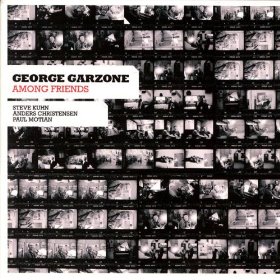 At 10:52 p.m., Garzone slipped away and Liebman took the lead. His solo was a cascade of notes, with Moses urging and surging. As Liebman pulled harder, the swing tempo disappeared and the band returned to free rhythm. Three minutes later, Liebman pulled Garzone back in with a couple of repeated phrases. What followed was one of those free-jazz moments you live for. The saxophonists whirled themselves into a firestorm of shouts and cries, with the other three pushing hard. Liebman began easing the performance out of the cyclone, dropping some repeated low tones into the mix. Lockwood immediately picked up that motif, and the drummers eased the energy downward. The entire group began aiming for a place to land. Liebman played more and more quietly, duetting elegantly with Garzone as the percussion subsided.
At 10:52 p.m., Garzone slipped away and Liebman took the lead. His solo was a cascade of notes, with Moses urging and surging. As Liebman pulled harder, the swing tempo disappeared and the band returned to free rhythm. Three minutes later, Liebman pulled Garzone back in with a couple of repeated phrases. What followed was one of those free-jazz moments you live for. The saxophonists whirled themselves into a firestorm of shouts and cries, with the other three pushing hard. Liebman began easing the performance out of the cyclone, dropping some repeated low tones into the mix. Lockwood immediately picked up that motif, and the drummers eased the energy downward. The entire group began aiming for a place to land. Liebman played more and more quietly, duetting elegantly with Garzone as the percussion subsided.
At 10:57 pm.m, there was no real pause, but the band made a definite segue to a third “tune.”
Garzone and Liebman, both on tenor, established a semi-ballad feel over Lockwood, playing arco. Moses added some atmospheric percussion. The two saxes were not trying for “pretty” harmony, but they held to a kind of consonance for a minute or so. As the harmonies slipped into more dissonant territory, Liebman took a short solo, and then Garzone came back in for more duet work.
Liebman stepped away and Garzone took command, soloing over the two drummers but standing closer to Moze’s kit and engaging more with him. His phrasing imitated speech, and the two began to sound as if they were in actual conversation. This hint became real—both of them briefly broke into wordless, spoken syllables, and Garzone wrapped up his spot back on tenor.
Moses took over for his solo, integrating vocal effects into the first few seconds. His rolls, pops, and rumbles blended into one another so artfully that it was hard to tell (especially in the dim light) where exactly the sounds were coming from. He began to move the music into the jungle.
Lockwood came in with a near ostinato figure, reinforcing the jungle feel, and Liebman moved to wooden flute. Gullotti came in, playing mallets. As if to emphasize that this was a group effort and not a “solo,” Liebman stayed seated.
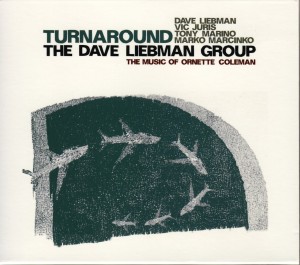 At 11:05 p.m., Liebman handed off to Garzone, also seated, who stayed in the undiscovered territory for about a minute. When Garzone stood up, the rhythm players responded immediately, bringing the music back towards the city. Garzone made a kind of “announcement” with a familiar, late-Coltrane note pattern that the music was changing direction. Liebman commented on the phrase on soprano and they briefly duetted.
At 11:05 p.m., Liebman handed off to Garzone, also seated, who stayed in the undiscovered territory for about a minute. When Garzone stood up, the rhythm players responded immediately, bringing the music back towards the city. Garzone made a kind of “announcement” with a familiar, late-Coltrane note pattern that the music was changing direction. Liebman commented on the phrase on soprano and they briefly duetted.
The saxophonists fell away for a dialogue of the drummers, with Lockwood providing a series of shivery, bowed rat-a-tats that punctuated the drum activity. Gullotti and Moses gave each other respectful space in the conversation. About half way through, Moses dropped in a martial figure; Gullotti immediately responded by bringing the energy up and adding more martial effects.
Liebman returned on soprano, and Garzone came back in shortly thereafter. Everyone knew that the percussion duet had said all that needed to be said; all that remained was to improvise a finale. They stayed at a medium-up feel for a minute or so and then, at 11:18 p.m., the set was over.
In less than an hour, there had been enough substance to send the first set crowd into the Cambridge night shaking their heads in amazement, spirits lifted, all else forgotten for a brief still time. Another houseful of listeners waited on the sidewalk for the second set.
Tagged: Bob Lockwood, Dave Liebman, George Garzone, Lily Pad, Rakalam Bob Moses

